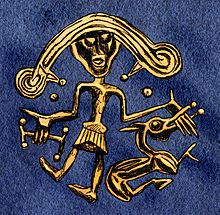
Back فنرير Arabic فنرير ARZ Fenrir BAR Фенрыр BE Фенрир Bulgarian Fenrir BR Fènrir Catalan Fenrir Czech Fenrisulven Danish Fenriswolf German



Fenrir (Old Norse 'fen-dweller')[3] or Fenrisúlfr (Old Norse "Fenrir's wolf", often translated "Fenris-wolf"),[4] also referred to as Hróðvitnir (Old Norse "fame-wolf")[5] and Vánagandr (Old Norse 'monster of the [River] Ván'),[6] is a monstrous wolf in Norse mythology. In Old Norse texts, Fenrir plays a key role during the events of Ragnarök, where he is foretold to assist in setting the world aflame, resulting in the collapse of humanity and society, and killing the god Odin.
Fenrir, along with Hel and Jörmungandr, is a child of Loki and female jötunn Angrboða. He is attested in the Poetic Edda, compiled in the 13th century from earlier traditional sources, and the Prose Edda and Heimskringla, composed in the 13th century. In both the Poetic Edda and Prose Edda, Fenrir is the father of the wolves Sköll and Hati Hróðvitnisson, is a son of Loki and is foretold to kill the god Odin during the events of Ragnarök, but will in turn be killed by Odin's son Víðarr.
In the Prose Edda, additional information is given about Fenrir, including that, due to the gods' knowledge of prophecies foretelling great trouble from Fenrir and his rapid growth, the gods bound him and as a result Fenrir bit off the right hand of the god Týr. Depictions of Fenrir have been identified on various objects and scholarly theories have been proposed regarding Fenrir's relation to other canine beings in Norse mythology. Fenrir has been the subject of artistic depictions and he appears in literature.
- ^ När Fenrir fick färg Archived 30 January 2021 at the Wayback Machine, by Magnus Källström, chief runologist at Swedish National Heritage Board.
- ^ Analysis supported as convincing in "Bite me" runestones Archived 30 January 2021 at the Wayback Machine by Henrik Williams, professor of North Germanic languages at Uppsala University.
- ^ Orchard (1997:42).
- ^ Simek (2007:81).
- ^ Simek (2007:160).
- ^ Simek (2007:350).